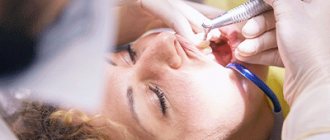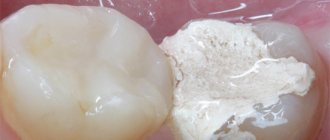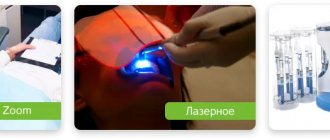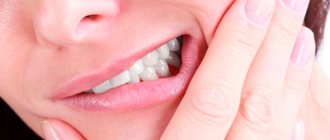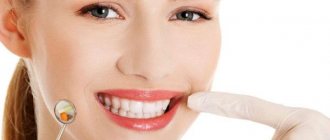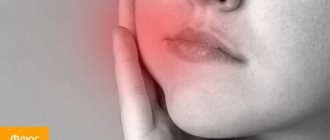Author of the article:
Soldatova Lyudmila Nikolaevna
Candidate of Medical Sciences, Professor of the Department of Clinical Dentistry of the St. Petersburg Medical and Social Institute, Chief Physician of the Alfa-Dent Dental Clinic, St. Petersburg
Many of you are probably familiar with this unpleasant state: as soon as you bite off a piece of chocolate or take the first sip of aromatic coffee, your teeth begin to “ache.” And let's be honest, "breaking" is an understatement. The jaw literally cramps with pain, and the skin instantly breaks out in goosebumps.
We’ll talk today about why the jaw suddenly begins to “ache” and the teeth begin to ache, and most importantly, how to get rid of such manifestations in the present and prevent them in the future.
How can discomfort manifest itself?
In the language of dentists, this phenomenon is called hypersensitivity or hyperesthesia. And the main causes of discomfort are abrasion and cracks of the enamel.
Pain from so-called aching teeth can manifest itself in different ways. Some patients have pain in all rows at the same time, and in some patients only 2-3 teeth hurt. The following manifestations are characteristic of hyperesthesia:
- Sharp aching pain of uncertain localization. A person complains that “the whole jaw begins to ache at once.”
- Severe pain when eating sweet/hot/cold foods and drinks.
- Pain localized to a specific part, such as the front teeth or back molars.
Dentists classify enamel hypersensitivity in different ways - according to the degree of prevalence, stage of occurrence and origin.
According to the degree of prevalence, hyperesthesia is divided into two types:
- Localized.
Occurs in the area of one or more teeth. This type of aches is caused by carious cavities and wedge-shaped defects in the necks of teeth. Sensitivity can also be caused by grinding down the enamel to install crowns. - Generalized.
This sensitivity spreads throughout the entire jaw. Hyperesthesia is provoked by periodontal tissue diseases, blooming caries and enamel erosion.
According to the causes of occurrence, hyperesthesia can be classified as follows:
- Hypersensitivity due to dental damage - caries, grinding and erosion of enamel.
- Hypersensitivity due to exposure of necks, tooth roots, as well as systemic pathologies in the body.
They are divided according to the stage of occurrence:
- 1st degree. Teeth ache due to temperature changes; the electrical excitability of dentin does not exceed 8 microamps.
- 2nd degree. Dentin begins to react not only to temperature, but also to chemical stimuli. Maximum electrical excitability is 5 microamps.
- 3rd degree. The teeth begin to cramp under any irritant, electrical excitability increases to 3 microamps.
Common Causes of Pain
Experts identify the following diseases that lead to the development of toothache:
- Caries. The development of caries leads to damage to tooth enamel and dentin. In the resulting carious cavity, pathogenic microorganisms accumulate and rapidly multiply. When caries reaches a complicated stage, harmful bacteria practically reach the pulp, which is penetrated by nerve fibers. Pain syndrome occurs under the influence of irritating factors.
- Pulpitis. At this stage, damage to the pulp occurs, an inflammatory process develops in it, which spreads to all nerve endings. Painful sensations can occur without any external signs of disease.
- Periodontitis. With this disease, the inflammatory process develops in the tissues surrounding the tooth.
- Flux. This complication appears in the absence of timely treatment of pulpitis. The danger is that the developed inflammatory process spreads to the jaw and periosteum.
- Non-carious lesions of the enamel and hard layers of teeth. They arise as a result of mechanical damage to the tooth, resulting in destruction of the enamel. The main cause of pain with such a lesion is the same processes that occur during diseases.
- After the tooth filling procedure. When filling is performed incorrectly, when the specialist performs the manipulations incorrectly or does not follow the correct procedure, the patient may experience unpleasant pain, which intensifies mainly at night.
- After tooth extraction. Painful sensations that worsen at night may develop after tooth extraction.
Causes of toothache
As we have already said, the main reason for such painful sensations is the thinning of the enamel. Hyperesthesia can also develop due to:
- dentin reactions;
- allergies to dental medications;
- periodontal diseases;
- mechanical damage to enamel;
- hereditary predisposition.
Let's look at each cause of the problem in more detail.
The tooth under the crown hurts when pressed
Crowns and bridges can also cause many unpleasant moments for their owner. Normally, you may feel discomfort under the crown for several days after installation, but as you adapt, the pain gradually goes away. If a month later the tooth still aches a lot and hurts when pressed, and also if the pain under the crown appears suddenly, this is a reason to consult a doctor.
There are four main reasons:
- the crown became loose, food particles and plaque accumulated under it, and inflammation began;
- the crown is cracked or split;
- the tooth is poorly ground under the crown;
- The shape of the crown is chosen incorrectly; it puts pressure on neighboring teeth or gums.
How might the nerve react?
Often teeth due to deep caries and pulpitis. And such “ache” will very soon turn into more serious, excruciating pain, not only when cleaning and eating hot or cold food, but also in a calm state, both day and night.
With pulpitis, a cavity develops in the coronal part and root canals of the teeth, where the nerve fibers are located, which over time fills with pus and blood. And although the epicenter of inflammation in this case is the nerve, the patient may initially complain that the whole row of teeth is “aching.” The sensations are localized in one tooth a little later, the pain becomes unbearable and requires the intervention of a dentist.
Visit to the dental office
When visiting a dental clinic, the specialist will conduct a thorough examination of the oral cavity, then prescribe the patient to undergo an x-ray examination. Images are necessary to determine the extent of tissue damage, detect the source of inflammation and make the correct diagnosis. Treatment of deep caries and pulpitis is carried out using the same methods. During treatment, the doctor:
- Provides local anesthesia by injecting an anesthetic into the tissue surrounding the diseased tooth.
- Eliminates affected tissue.
- Performs mechanical and antiseptic treatment of canals.
- Performs canal fillings.
- Takes a control photograph of the tooth.
- Restores the damaged part of the tooth.
After undergoing treatment for deep caries or pulpitis, the patient may still feel discomfort and unpleasant sensations for some time, which should subside over several days. In case of periodontitis and periostitis, it is initially necessary to eliminate the source of infection. To do this, root canals are cleaned and processed. Treatment of gumboil and periodontitis takes longer. After eliminating the source of infection, the canals are filled and the crown of the tooth is restored. Sometimes surgical methods are used to treat flux. If you ignore the problem and do not seek the help of a dentist, then the chances of saving the tooth are greatly reduced. If acute toothache occurs due to the eruption of the eighth tooth, then it is very important to promptly seek the advice of a specialist. After examining the oral cavity and conducting an X-ray examination, the doctor will select the most effective treatment method in each specific case. The dentist begins performing therapeutic procedures after administering local anesthesia. Modern anesthetics are highly effective and well tolerated by the body.
Thinning enamel
Tooth enamel can become thinner for a variety of reasons, such as:
- improper bleaching or poor-quality professional cleaning;
- using brushes that are too hard;
- using pastes with abrasives that expose the enamel to chemical and mechanical stress;
- vitamin deficiency (the pain in this case is characterized by an aching, twitching character and manifests itself during cleaning, rinsing the mouth, eating and drinking).
How to preserve tooth enamel
It is important to know how to care for tooth enamel to prevent the development of pathologies. Experts give advice on how to preserve tooth enamel and not cause deformation. It is necessary to adjust your diet, consume sufficient amounts of protein, calcium, fluoride and vitamin D. It is recommended to reduce sugar consumption and stop smoking.
Dentists recommend giving up the bad habit of chewing pens, pencils, and brushes. Clean daily with a soft brush that does not damage the gums. It is important to remove plaque and food particles using dental floss. Regular visits to the dentist will help prevent the development of hyperesthesia.
If a person has weak protection from nature, then it is possible to undergo a remineralization procedure according to indications. A special composition will protect the surface and reduce sensitivity. Those who regularly experience seasonal manifestations of hyperesthesia are recommended to regularly cleanse with special pastes to instantly reduce sensitivity. A medical specialist may suggest installing veneers not only to correct position and color, but also to reduce pathological sensitivity.
Dentin reaction
Dentin is the hard tissue of the tooth underneath the enamel. This is a layer that, after damage, can allow irritants to pass into the nerve zones. Dentin is destroyed during advanced stages of caries, and can also occur with inadequate dental treatment if an infection develops under a filling.
If teeth ache for this reason, the patient feels a drilling, sharp pain, similar to the sensations of purulent pulpitis.
In very rare cases, teeth ache due to the patient’s individual intolerance to certain dental medications, after visiting a doctor. In this case, the pain is accompanied by itching in the gums and palate.
Treatment of hyperesthesia in the “Family Doctor”
If hyperesthesia occurs, make an appointment with a dentist by calling the contact center in Moscow +7 (495) 775 75 66 or using the online appointment form. Our clinic has been operating for more than 26 years. Experienced doctors help patients cope with pressing problems, including hypersensitivity.
The doctor will find out the cause of tooth sensitivity and provide effective treatment. In most cases, it is enough to select suitable oral care products and carry out proper hygiene procedures. In more complex situations, full treatment is used, and if necessary, surgical treatment.
The clinic takes a gentle approach to patients. All procedures are accompanied by adequate pain relief, which eliminates the occurrence of discomfort and pain. Increased sensitivity of teeth is not just a feature of them. This is the beginning of a disease that must be cured. And it's better to do it as quickly as possible.
How to relieve pain?
If aches and pain in your teeth caught you in the middle of the night, and you only made an appointment with the doctor the day after tomorrow, try to relieve the painful sensations for a while. Here are some popular and effective ways to temporarily soothe aching teeth.
- Acupressure
will help relieve discomfort for a couple of hours. Try massaging the grooves between the phalanges of the index and thumb, the base of the ears, and the area between the cheekbone and lower jaw. - Rinse
. For an anesthetic rinse, a decoction of chamomile, St. John's wort, lemon balm, mint or oregano is suitable. Just pour 1-2 tablespoons of the dry plant with a glass of boiling water, and then keep the composition in a water bath for 20 minutes. If there are no medicinal herbs in your home medicine cabinet, rinse your mouth with a salt solution. Dissolve a teaspoon of the substance in a glass of water and begin therapy. - Painkillers
will help you rest before your visit to the doctor and relieve aching teeth. Dentists advise choosing new painkillers with each new attack of pain - Nurofen, Analgin, Ketanov, paracetamol, aspirin. However, do not under any circumstances overdo it with pills! Firstly, these drugs are addictive, and secondly, they have a bad effect on the liver, kidneys, gastrointestinal tract and other systems in the body. - Clove, mint and sea buckthorn oils
will help relieve pain and even relieve swelling of the gums. For pain relief, it is enough to soak cotton swabs and cover the sore teeth. Tampons should be changed every 2 hours. - Propolis
is an excellent natural anesthetic, similar in action to novocaine. To pacify dental aches and pain, you can wipe the gums with an alcohol solution of propolis or moisten cotton wool with it and cover the sore tooth. Some dentists advise using propolis in plates: you can simply cover the hole with a piece of the substance or put propolis on the gum near the tooth. The product is prohibited for patients who suffer from allergies to honey and other bee products. - Garlic,
according to patient reviews, helps to forget about the painful aches for a couple of hours. You can use a cut or ground clove, applying it to a sore tooth, or chew garlic with black bread and hold it in your mouth. This vegetable warms the skin, so it can be used as an irritant for acupuncture points. To soothe a toothache, a paste of two cloves of garlic should be applied to the inside of the wrist on your hand (the opposite side on which the tooth hurts). The medicine is fixed on the skin with a bandage and lasts for several hours. - radishes
have been used to treat toothache and gum inflammation. To prepare a natural analgesic, you need to wash the vegetable, peel it from the skin and grate it on a fine grater, and then pour 2 tablespoons of the pulp with 0.5 liters of boiling water. To relieve pain with the composition, you need to rinse your mouth every hour. - Plantain root
is an excellent summer analgesic. Simply rinse it and apply it to the sore tooth. After 20-30 minutes the pain will go away.
For toothache of infectious origin, Asepta Active mouth rinse is an effective analgesic, antibacterial and anti-inflammatory agent. This product combines a combination of benzydamine and chlorhexidine, which not only has a pronounced antibacterial effect, but also prevents inflammation and bleeding of the gums, freshens breath and prevents the formation of plaque.
What to do if your tooth hurts badly at night
It should be remembered that all independent procedures will only help temporarily reduce pain and not eliminate the disease. The most common folk methods include:
- Painkillers. Such medications effectively help eliminate unpleasant symptoms, which alleviates the general condition of a person. The dosage of drugs should be taken according to the instructions. Overdosing on a medicine can cause serious problems.
- The use of tinctures of medicinal herbs for rinsing the mouth. The following herbs are suitable for these purposes: calendula, oak bark, calamus root, chamomile, plantain and sage. They have anti-inflammatory and antiseptic effects. Infusions should be used only if there are no allergic reactions to the herbs used.
- Rinse with salt solution. This solution helps to temporarily eliminate discomfort and make you feel better. It does not cause allergies.
If the temperature rises sharply or swelling occurs, this may be a sign of the spread of the inflammatory process. In such a situation, you must immediately seek the help of a specialist.
What is absolutely forbidden to do?
In order not to double the painful sensations of aching in the jaw, it is important to adhere to several rules before visiting a doctor:
- Regularly clean the oral cavity of food debris; sometimes it is particles from lunches and dinners that often become the cause of especially severe pain in pulpitis and periodontitis.
- Never chew on the side of the affected tooth.
- Heating a sore spot is strictly prohibited. Any hot compresses increase blood flow and increase pain.
- Try not to be in a lying position; this position activates blood circulation in the periodontal tissues and increases pressure on them.
We have listed the main ways to relieve toothache. However, these methods, with all their diversity, will not help cure the cause of the unpleasant manifestation and are only a temporary measure. As soon as you feel your teeth hurting, make an appointment with the dentist. Believe me, the sooner you start treatment, the faster and cheaper you will get rid of painful sensations.
Why it hurts to press on a tooth - the main reasons
The causes of pain in a molar, incisor or canine when pressing on it can be very different. Below we will talk about the most common ones.
Increased sensitivity
If unpleasant sensations are associated precisely with this, then they can remind of themselves without any serious reasons. A person simply needs to clench their jaws more tightly to experience discomfort. In such a situation, you should use special toothpastes and remineralizing gels. Pharmacy mouth rinses will also help improve the situation.
If it is not possible to eliminate the manifestations of the pathological condition using standard hygiene products, it is recommended to make an appointment with a dentist. The dentist will treat the teeth with a fluoride-containing strengthening composition, which will improve the situation.
Traumatic injuries (history or recent)
A very common reason. Usually a person who has suffered a jaw injury understands what causes his discomfort. It is important to realize that injuries are not necessarily the result of falls or fights. Sometimes it's enough to eat a handful of nuts or chew crackers to get a problem.
When exposed to mechanical stress, cracks appear on the enamel surface. They are the ones who cause unpleasant dental symptoms. It is not possible to close them on our own. It is imperative to visit a doctor so that he can provide the necessary treatment.
Periodontitis
Complication of advanced caries, injury or poorly performed dental treatment. With it, the periodontium becomes inflamed - a narrow space located between the crown and the socket. The pathology occurs in acute or chronic form.
Therapy for periodontitis must be comprehensive. Need to:
- get rid of the inflammatory focus;
- clean the dental canals and create conditions for the unhindered outflow of exudate;
- administer antibiotic therapy;
- use medicinal baths.
Good dynamics during the disease are provided by UHF to the affected area.
Gum inflammation
Another reason why a tooth hurts when pressed. Here you need to carry out a differential diagnosis - first press on the gum, and then on the crown. If the problem is damage to soft tissues, then a negative symptom will arise precisely when pressing on them.
Treatment for gum inflammation includes:
- carrying out anti-inflammatory baths;
- exclusion of irritating factors that negatively affect the gums;
- carrying out physiotherapeutic procedures, gum massage;
- vitamin therapy;
- mouth rinse;
- oral administration of medications that help to quickly relieve inflammation.
Poor quality dental prosthesis
It is very important that the installed structure exactly matches the characteristics of the patient’s oral cavity . It is unacceptable for artificial units to be higher or lower than those given by nature. This will create unnecessary pressure on antagonistic neighbors.
It also happens that the doctor performed poor-quality root canal treatment before prosthetics. This led to inflammation. Then you will have to remove the prosthesis and re-treat the canals, and then repeat the prosthetics from the very beginning.
Of course, such situations are very unpleasant and leave a lot of negative emotions and experiences in the patient’s memory. That is why it is so important not to go to a clinic where it is cheaper, but to contact experienced doctors who guarantee the impeccability of the final result.
Cyst
They speak of a root cyst when they see a spherical formation filled with liquid contents . It appears after an injury, as a result of infection of the root canals, due to the introduction of infection into the periodontal zone by a non-sterile medical instrument.
It is important to establish the true cause of the cyst and carry out its step-by-step treatment. When the situation returns to normal, pain symptoms will cease to bother you.
Caries
It would seem that it is not difficult to notice caries and understand that it is the cause. But it is not always the case.
If the carious cavity is at the spot stage , it may be completely invisible to a person. The situation is similar if the “hollow” is located between neighboring units.
To understand the root cause of the problem, you need to conduct a dental examination. To reduce the risk of cavities, you should have checkups at your dentist's office every six months.
Pulpitis
A disease that every person faces sooner or later. It affects nerves and blood vessels located in the root system. With pulpitis, painful symptoms occur:
- when pressed;
- when eating cold or hot food;
- when trying to chew something hard.
Treatment is carried out under local anesthesia. The doctor opens the upper part of the crown and puts in the medicine. After the specified period, the patient comes for a follow-up appointment. Then the medicine is removed, the canals are cleaned, expanded and sealed. Finally, a permanent filling is installed.
It is very important not to delay treatment of pulpitis. This disease is very insidious. Among its consequences:
- destruction of bone tissue;
- periostitis;
- periodontitis;
- destruction of the ligaments holding the canine, incisor or molar (this leads to its loosening and premature loss).
Clinical researches
Repeated clinical studies have proven that the two-component mouth rinse ASEPTA ACTIVE more effectively combats the causes of inflammation and bleeding compared to single-component rinses - it reduces inflammation by 41% and reduces bleeding gums by 43%.
Sources:
- The effectiveness of the use of Asept “adhesive balm” and Asept “gel with propolis” in the treatment of chronic generalized periodontitis and gingivitis in the acute stage (Municipal Dental Clinic No. 4, Bryansk, Kaminskaya T. M. Head of the therapeutic department Kaminskaya Tatyana Mikhailovna MUZ City Dental Clinic No. 4, Bryansk
- Study of the clinical effectiveness of treatment and prophylactic agents of the Asepta line in the treatment of inflammatory periodontal diseases (A.I. Grudyanov, I.Yu. Aleksandrovskaya, V.Yu. Korzunina) A.I. GRUDYANOV, Doctor of Medical Sciences, Prof., Head of Department I.Yu. ALEXANDROVSKAYA, Ph.D. V.Yu. KORZUNINA, asp. Department of Periodontology, Central Research Institute of Dentistry and Maxillofacial Surgery, Rosmedtekhnologii, Moscow
- The role of anti-inflammatory rinse in the treatment of periodontal diseases (L.Yu. Orekhova, A.A. Leontyev, S.B. Ulitovsky) L.Yu. OREKHOVA, Doctor of Medical Sciences, Prof., Head of Department; A.A. LEONTIEV, dentist; S.B. ULITOVSKY, Doctor of Medical Sciences, Prof. Department of Therapeutic Dentistry of St. Petersburg State Medical University named after. acad. I. P. Pavlova
- Report on the determination/confirmation of the preventive properties of personal oral hygiene products “ASEPTA PLUS” Remineralization doctor-researcher A.A. Leontyev, head Department of Preventive Dentistry, Doctor of Medical Sciences, Professor S.B. Ulitovsky First St. Petersburg State Medical University named after. acad. I.P. Pavlova, Department of Preventive Dentistry
How to care for teeth enamel after polishing and whitening
The thickness of the protective cover varies from 2 to 2.5 mm. With thinning, increased sensitivity appears. Taking care of your teeth after professional cleaning or polishing will not only prolong the effect, but also allow you to experience less discomfort. During such procedures, the protective layer becomes very thin and, if not properly cared for, its structure may be damaged.
Dentists recommend using toothpastes to reduce tooth sensitivity and regularly using special rinses and dental floss. Immediately after the procedure, it is strictly forbidden to smoke or drink drinks that are too hot or too cold. At night, they may recommend wearing a mouth guard with a special gel. Increased sensitivity in the first days after the procedure is a standard side effect.
Care after teeth whitening includes a “white diet”. It is prohibited to consume foods with high concentrations of coloring substances. This includes wine, coffee, berries, colored vegetables and fruits, soda, spices, and products with a high cocoa content. Sticking to a strict diet is especially important in the first two weeks after whitening.
It is recommended to consume more fish, white meat, egg whites, dairy products and rice. All foods that can damage the thinned surface are excluded from the diet. Strictly monitor the temperature, as changes will negatively affect the appearance and health of the oral cavity. All restrictions are introduced only for the first 14 days after the dental procedure.
Hyperesthesia interferes with the usual way of life. It is painful to eat and drink, and discomfort occurs when the temperature changes. Fluoridation may be needed. The disease must be treated only under the supervision of a specialist. It is important to exclude products that are harmful to enamel and follow hygiene rules.
